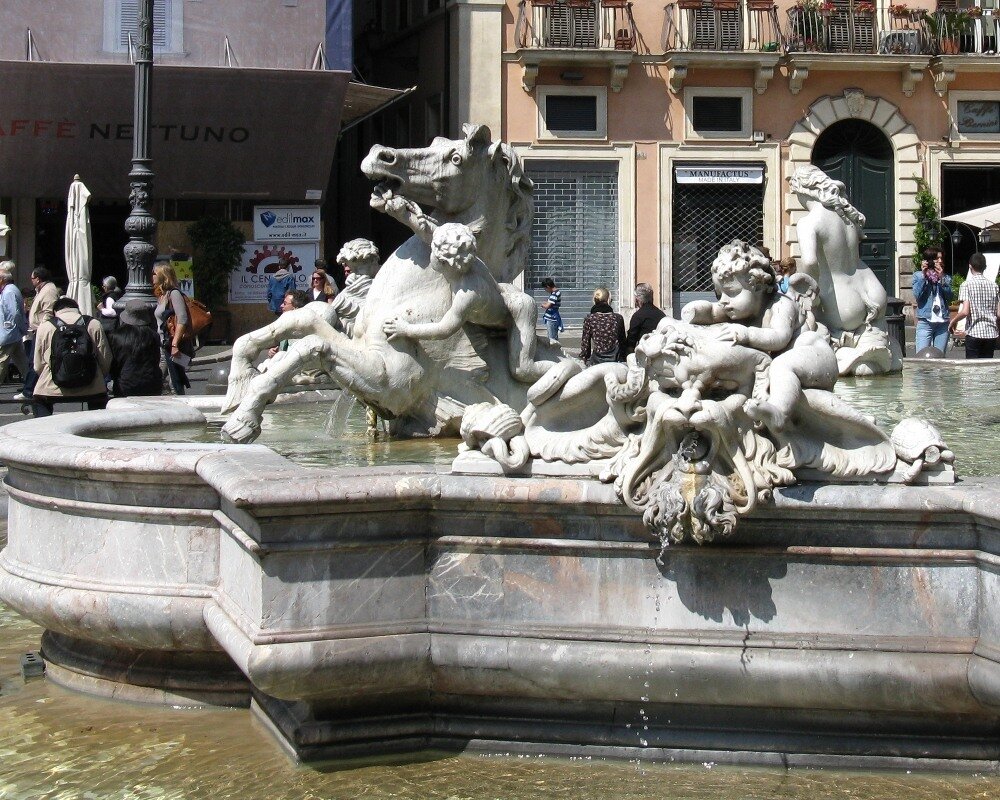Navona Square (Piazza Navona)
Between the Pantheon and Piazza Navona is the Church of San Luigi dei Francesi (Sancti Ludovici Francorum de Urbe on the map), built in 1589. The temple was not dedicated to Saint Luke, as you might think, but to the king of France, Louis IX, and it was built by French craftsmen.

The architect of the project is not known for certain, but it is believed that the facade was designed by Giacomo della Porta. In the temple, you can see several paintings by Caravaggio.

Piazza Navona (on the map) was formed on the site of a stadium built by Julius Caesar, and almost repeats its shape. In the middle ages, the ruins of the stadium's stands were used as foundations for buildings, and the former arena became a square. Here began to hold fairs and other public events, and in 1477, the city market was moved here from the foot of the Capitoline hill.

Dominating the square is the Baroque Church of Sant'agnese in Agone (Chiesa di Sant'agnese in Agone on the map) dedicated to the early Christian Martyr Saint Agnes of Rome. The Romans call the Church simply "Saint Agnes". According to legend, on January 21, 305, a Christian woman named Agnes was executed at the stadium. Before the execution, she was stripped of her clothes, but a miracle happened - instantly regrown hair covered her nakedness. Nevertheless, the Martyr was beheaded. The body was stolen by co-religionists and buried in the catacombs, and in the 8th century a chapel was built on the place of execution, where the head of the Saint was placed.

Храм строился по указанию папы Иннокентия X Памфиля, семья которого владела здешними землями. Церковь примыкала к фамильной резиденции и выполняла функции частной часовни. Портал храма украшен гербом папы.

Первоначальный проект разработал Джироламо Райнальди в 1652 году, однако строительство началось на следующий год уже под руководством Франческо Борромини.

Проект был несколько изменен - были раздвинуты колокольни, а фасад стал вогнутым, для того чтобы сделать акцент на купол храма.

Купол спроектировал Джованни Мария Баратта, фонарь над ним работы Карло Райнальди украшен коринфскими колоннами.

Алтарь был воздвигнут над средневековой часовней с головой Агнессы, которая стала криптой храма. В 1655 году, задолго до завершения строительства, здесь был погребен и заказчик храма. Церковь была освящена 17 января 1672 года.

В центре площади, напротив церкви Святой Агнессы, находится один из известнейших фонтанов Рима - Фонтан Четырёх рек (Fontana dei Quattro Fiumi). Фонтан, как и церковь, появились по инициативе Папы Иннокентия, пожелавший видеть перед храмом "египетский" обелиск (римская имитация времен Домициана). Был объявлен конкурс проектов, однако предпочтение было отдано работе гения итальянского барокко Джованни Лоренцо Бернини. Из-за интриг злопыхателей великий архитектор и скульптор не был допущен у проекту, однако нашел способ продемонстрировать макет заказчику. Папа был восхищен работой и в 1648 году началось строительство, длившееся 3 года.

Фонтан посвящен речным богам величайших из известных в те времена рек - Нила, Дуная, Ганга и Ла-Платы.

In the Northern part of the square, the fountain of Neptune (Fuente del Neptuno) was built in 1576. The author of the project is the architect Giacomo della Porta.

Initially, the fountain looked more modest, but it received its current appearance after reconstruction in 1873.

Then there was a stone pool with statues of "Neptune fights with an octopus" and "Nereids with putti and hippocampus" made by Gregorio Sapallo and Antonio della Bita.
